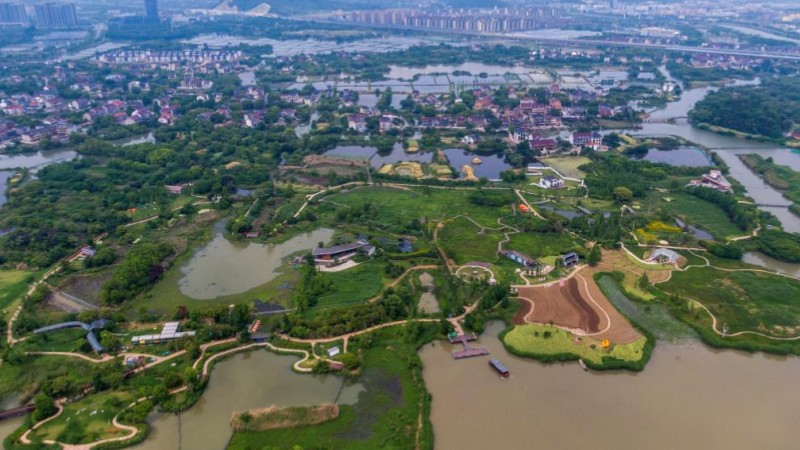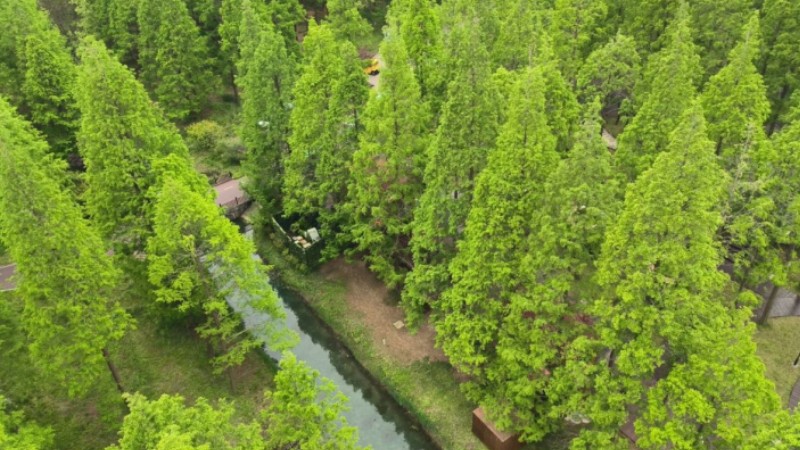Digital tech restore relics in museum in E China's Hangzhou
Thanks to the ingenious use of digital technologies, a museum featuring the remains of Deshou Palace, a royal palace dating back to China's Southern Song Dynasty (1127-1279) in Hangzhou, capital of east China's Zhejiang Province, has brought more people closer to the royal life and palaces in the Southern Song Dynasty, while inheriting and protecting historical and cultural relics.

The first photo shows a digital exhibition of a museum featuring the remains of Deshou Palace, a royal palace dating back to China's Southern Song Dynasty (1127-1279) in Hangzhou, capital of east China's Zhejiang Province. (Photo/Li Yuanchu)
The second photo shows the exterior of a museum featuring the remains of Deshou Palace, a royal palace dating back to China's Southern Song Dynasty (1127-1279) in Hangzhou, capital of east China's Zhejiang Province. (Photo/Yu Guangming)
The reconstructed Chonghua Hall, the main building of the Deshou Palace, and the digital facilities at the remains of the hall introduce visitors to the rise and fall of the Deshou Palace and the exquisite craftsmanship and design of buildings in the Song Dynasty (960-1279).
Chonghua Hall has been reconstructed according to historical materials, said Zhou Ji, an executive of the museum. The remnants of the hall, considered to be the essence of the museum, have been carefully preserved and are kept in good condition below the ground level of the reconstructed hall.
Visitors can now see under the glass paths of the museum the relics of the Deshou Palace, including the characteristic bricks, bases of columns, and cornerstones in the Southern Song Dynasty.
"The remains have been through a lot for more than nearly 1,000 years. It may be hard to imagine how magnificent this palace used to be just by viewing these relics," Zhou told People's Daily.
As she spoke, three giant curtains descended slowly at the north, east and west ends of the remains of Chonghua Hall, forming an enclosed space with the area where the relics are located. Shortly after, a narration was accompanied by music.
While light fell on the relics, the three-dimensional projection of the foundations of the Chonghua Hall started to grow taller, and the construction process of the hall was simulated on the original site of the building.
Visitors hailed the vivid digital demonstration.
"It's an effective and vivid demonstration. The virtual process of building the Chonghua Hall on these unimpressive stone piers has helped laypeople like us understand relics," a visitor surnamed Wang said to her friends after watching the demonstration.
"Displaying and explaining the remains and providing an immersive experience for visitors at the site is the highlight of the digital exhibition at the remains of Deshou Palace," said a leader of the team responsible for the digital restoration and exhibition of the remains of the palace.
Besides showing the remains of the foundations of the Deshou Palace, the western area of the museum uses digital technologies to help visitors learn about the beauty of gardens and the elegant lifestyle in the Southern Song Dynasty.
Digital facilities have been installed at eight spots in an area of over 3,600 square meters, with the remains of the rear court room of a hall, ditch, pavilion, and office building, among other buildings.
Transparent display screens using augmented reality (AR) technology beside the remains of the ancient buildings can simulate and display the original appearance of the buildings, and reproduce the scenes of ancient people, making it easier for visitors to understand the relics.
Images of water waves, lotus leaves, and fish are also projected on the remains of a ditch in the Deshou Palace, vividly showing the graceful atmosphere of gardens in the Southern Song Dynasty.
A 30-meter-long dynamic scroll reproduces scenes of Emperor Gaozong touring the gardens after he abdicated and moved to Deshou Palace. By displaying the scenes of Emperor Gaozong in the order of the 24 solar terms of the Chinese lunar calendar, the scroll, which is based on historical records, effectively enhances the visitors' understanding of royal life in ancient China.
"By integrating digital technologies into the remains of Deshou Palace, the museum allows visitors to 'travel through' time and space," said Diao Changyu, deputy director of the Laboratory of Art and Archaeology Image, Zhejiang University.
"Digital growth" highlights the value of the remains of Deshou Palace, said Diao, who has been deeply involved in the digital information collection of cultural heritage.
The museum couldn't have had a successful, authentic and comprehensive digital exhibition of historical remains without interdisciplinary cooperation among members of a restoration research team, according to Zhou. Researchers in fields including archaeology, architecture, history, and museology have been brought together to form a research team to support the digital exhibition of the museum, she explained.
Since it opened in November 2022, the museum has received more than 200,000 individual visits and over 800 group visits.
"We are very popular now. We allow 1,500 pre-booked visits a day. And the tickets are often sold out within a minute," said Zhou.
"We will enhance promoting our museum online. For example, we may create online digital exhibition halls to build connections between people and the remains of Deshou Palace to promote the historical and cultural heritage of the Song Dynasty," she added.
Photos
Related Stories
- Fujian Museum to serve as China's main venue for World Museum Day
- Museums, art galleries get sought-after during May Day holiday
- Cao Cao Mausoleum Museum in China's Henan to open to public
- China Space Museum reopens to public after renovation
- Museum in NW China's Gansu uses latte art to give more people a taste of culture
- Chinese aviation history museum takes off in Beijing
Copyright © 2023 People's Daily Online. All Rights Reserved.









